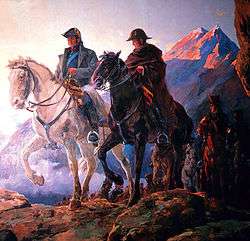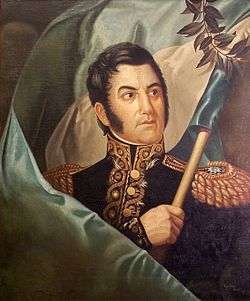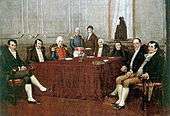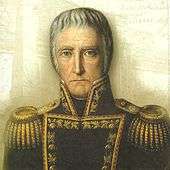British invasions of the River Plate
| British invasions of the River Plate | |||||||
|---|---|---|---|---|---|---|---|
| Part of Anglo-Spanish War (1796–1808) | |||||||
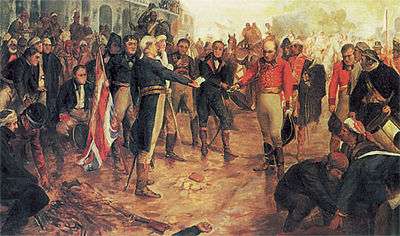 Above: William Beresford surrenders to Santiago de Liniers (1806) | |||||||
| |||||||
| Belligerents | |||||||
|
| |||||||
| Commanders and leaders | |||||||
|
|
| ||||||
| Strength | |||||||
|
First invasion:
Second invasion:
|
First invasion:
Second invasion: | ||||||
| Casualties and losses | |||||||
|
First invasion: 205 dead and wounded[6] Second invasion (Montevideo): 1,500 casualties Second invasion (Buenos Aires): 600 killed and wounded[1] [7] |
First invasion: 157 dead and wounded, 1,300 captured[8] Second invasion (Montevideo): 600 casualties Second invasion (Buenos Aires): 311 killed, 208 missing, 679 wounded, 1,600 captured[1] [9] | ||||||
The British invasions of the River Plate were a series of unsuccessful British attempts to seize control of areas in the Spanish colonial Viceroyalty of the Río de la Plata that were located around the Río de la Plata in South America — in present-day Argentina and Uruguay. The invasions took place between 1806 and 1807, as part of the Napoleonic Wars, when Spain was an ally of Napoleonic France.
History
The invasions occurred in two phases. A detachment from the British army occupied Buenos Aires for 46 days in 1806 before being expelled. In 1807, a second force stormed and occupied Montevideo, remaining for several months, and a third force made a second attempt to take Buenos Aires. After several days of street-fighting against the local militia and Spanish colonial army, in which half of the British forces were killed or wounded, the British were forced to withdraw.
The social effects of the invasions are among the causes of the May Revolution. The criollos, who had so far been denied important positions, could get political strength through military roles. The successful resistance with little help from Spain fostered the desire for self-determination. An open cabildo and the Royal Audience of Buenos Aires deposed the viceroy Rafael de Sobremonte and designated instead the French popular hero Santiago de Liniers, which was a completely unprecedented action: before that, the viceroy was only subject to the King of Spain himself, and no one from the colonies had authority over him.
Background
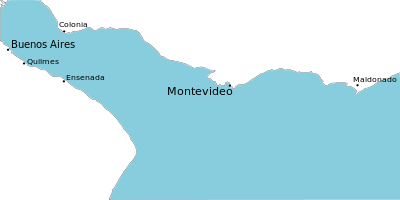
Pedro de Mendoza founded the Ciudad de Nuestra Señora del Buen Ayre (Our Lady of the Fair Winds) on 2 February 1536 as a Spanish settlement. The site was abandoned in 1541, but re-established in 1580 by Juan de Garay with the name Ciudad de la Santísima Trinidad y Puerto de Santa María del Buen Ayre, and the city became one of the largest in the Americas. A Portuguese colony was founded nearby at Colonia del Sacramento in 1680. To deter Portuguese expansion, the Spanish founded Montevideo in 1726, and Colonia was finally ceded to Spain under the Treaty of San Ildefonso in 1777, one year after the creation of the Spanish Viceroyalty of the Río de la Plata, the forerunner of modern Argentina.
The South Sea Company was granted trading concessions in South America in the time of Queen Anne, under the Treaty of Utrecht. The British had long harboured ambitions in South America, considering the estuary of the Río de la Plata as the most favourable location for a British colony.
The Napoleonic Wars played a key role in the Rio de la Plata conflict and since the beginning of the conquest of the Americas, England had been interested in the riches of the region. The Peace of Basel in 1795 ended the war between Spain and France. In 1796, by the Second Treaty of San Ildefonso, Spain joined France in its war with Britain, thus giving Britain cause for military action against Spanish colonies. In 1805 Britain judged it the right moment after the defeat of the Franco-Spanish fleet at the Battle of Trafalgar. This battle forced Spain to reduce to a minimum its naval communications with its American colonies. Historically, Buenos Aires had been relatively neglected by Spain, which sent most of its ships to the more economically important city of Lima. The last time when a significant Spanish military force had arrived in Buenos Aires was in 1784.[2]
British interest in the region
There were six Anglo-Spanish Wars from 1702 to 1783, most of which lasted for several years and Britain had long harboured interests in taking control of the region from the Spanish before the invasions.
Back in 1711, John Pullen stated that the Río de la Plata was the best place in the world for making a British colony. His proposal included Santa Fe and Asunción, and would have generated an agricultural area with Buenos Aires as the main port. Admiral Vernon also declared the benefit of opening markets in those areas in 1741. By 1780 the British government approved a project of colonel William Fullarton to take the Americas with attacks from both the Atlantic (from Europe) and the Pacific (from India). This project was cancelled.[10]
In 1789 the war between Britain and Spain seemed imminent after the Nootka incident. The Venezuelan revolutionary Francisco de Miranda took the opportunity to appear before prime Minister William Pitt with his proposal to emancipated the New World territories under Portuguese and Spanish rule and turn them into a great independent empire governed by a descendant of the Incas. The plan presented in London requested the assistance of the United Kingdom and the United States to militarily occupy the major South American cities, ensuring that the people would greet cordially British and would be rushing to organize sovereign governments. In return for this help, would get the benefits of unrestricted trade and usufruct of the Isthmus of Panama, in order to build a channel for the passage of ships. Pitt accepted the proposal and began to organize the expedition. The Nootka Convention in 1790 ended hostilities, and Miranda mission was canceled.
Nicholas Vansittart made a new proposal in 1796: the plan was to take Buenos Aires, then move to Chile and attack from there the Spanish stronghold of El Callao in Peru. This proposal was canceled the following year, but was improved by Thomas Maitland in 1800 as the Maitland Plan. The new plan was to seize control of Buenos Aires with 4,000 soldiers and 1,500 cavalry, move to Mendoza, and prepare a military expedition to cross the Andes and conquer Chile. From there, the British would move from sea to seize Peru and then Quito.[11]

All these proposals were discussed in 1804 by William Pitt, Lord Henry Melville, Francisco de Miranda and Sir Home Riggs Popham. Popham did not believe a complete military occupation of South America was practical but argued for taking control of key locations to allow the main objective, to open new markets for the British economy. Although there was consensus for weakening Spanish control over its South American colonies, there was no agreement as to the system and the moment to take such action. For instance, it was not even agreed whether the cities be turned into British colonies after their capture or just be made into British protectorates.[13]
First invasion
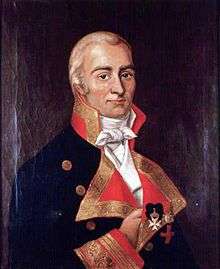

In 1805 Popham received orders to escort the David Baird-led expedition against the Dutch colony of the Cape of Good Hope, which was allied with Napoleon. With nearly 6,300 men they took it in January 1806. Popham received new orders from the admiralty to patrol the east coast of South America, from Rio de Janeiro to the Río de la Plata, in order to detect any attempt to counterattack the Cape. However, Popham had the idea of taking the Río de la Plata with a military action similar to the one made at the Cape. His agent William White had informed him about the local politics of the city, such as the discontent among some groups about the restrictive regulations enforced by Spain about international commerce. Popham manifested Baird his will to take the zone, with or without his help. Baird gave him the 71st Regiment of Infantry, artillery and 1,000 men to attempt the invasion. Baird promoted William Carr Beresford to general and designated him vicegovernor of the zone if it was taken. The expedition got reinforcements of 300 men from the Artillery and [St Helena] Regiment.[14]
The Spanish Viceroy, Marquis Rafael de Sobremonte, had asked the Spanish Crown for reinforcements many times, but only received a shipment of several thousand muskets and instructions to form a militia. Buenos Aires was then a large settlement housing approximately 45,000, but the Viceroy was reluctant to give weapons to the Creole population. The best troops had been dispatched to the Upper Peru currently Bolivia to guard the frontiers from Túpac Amaru II's revolt, and when Sobremonte learned of the British presence in the area he dispatched the remaining troops to Montevideo, considering that the attack would be in that city. Thus, the British found Buenos Aires almost defenseless.
.svg.png)
Part of a series on the |
|---|
| History of Argentina |
 |
|
|
Post-WW II (1955 to 1976) |
|
Return to democracy |
|
|
The British took Quilmes, near Buenos Aires, on 25 June 1806, and reached and occupied Buenos Aires on 27 June. The Viceroy fled to Córdoba with the city's treasury, but lost it to British forces during his escape. Although his action was in line with a law enacted by former Viceroy Pedro de Cevallos, which required the treasury to be kept safe in case of a foreign attack, he was seen as a coward by the population because of it.[15]
The wealthy members of society were not pleased with the British arrival.[16] Nevertheless, the politicians swore loyalty to them, such as the members of the Cabildo or the Consulates, with the exception of Manuel Belgrano who said "Queremos al antiguo amo o a ninguno" (we want the old Master or none at all), leaving to the Banda Oriental, now Uruguay. Religious leaders swore loyalty as well, after securing the promise that the catholic religion would be respected. The Real Audience ended its activities. The rich people included the British among their celebrations, and those promised that their slaves wouldn't be emancipated. However, the bulk of the population did not like the new situation and rejected the British. Merchants were also displeased by the repeal of the Spanish monopoly of commerce and the opening to free trade, as it harmed their interests; one of their leaders was Martín de Álzaga.

De Álzaga organized the digging of a secret tunnel to the fort, where the British were located, with the purpose of filling it with explosives and attacking the invaders by surprise. Juan Martín de Pueyrredón organized a militia near the city, but was discovered before being ready, and his troops were defeated. Santiago de Liniers, who was assigned to guard a nearby coast defense, got into the city and weighed the situation. He convinced Álzaga to hold on his plan, and moved to Montevideo. The governor Ruiz Huidobro gave him command of 550 veterans and 400 soldiers to return to Buenos Aires and attempt the re-conquest. Sobremonte was doing the same in Córdoba, but Liniers got to Buenos Aires first.


On 4 August 1806, Liniers landed at Las Conchas, north of Buenos Aires, and advanced with a mixed force of Buenos Aires line troops and Montevideo Militia toward the city. On 10 August he took control of the strategic points of Miserere and El Retiro, holding the north and west entries to the city. Beresford finally surrendered on 14 August. An open cabildo decided afterwards to depose Sobremonte from having military authority, and giving such authority, instead, to the victorious Liniers. As written above, Sobremonte's departure at the beginning of the war made him highly unpopular among the peoples of Buenos Aires. Sobremonte would not return to Buenos Aires, and moved to Montevideo instead. The open cabildo also decided to prepare the city against the possibility of a British counter-attack.
Foreseeing the possibility of a second invasion, militias were formed by the Spanish and criollos, such as the Patricios,[17] Arribeños, Húsares (of Pueyrredón), Pardos and Morenos. The creation of such local forces created concern within the Spanish elite, fearful of an attempt of secession from the Spanish Crown.
On this first invasion, the 71st Regiment of Foot lost both of its Regimental Colours during the combat, which are currently held in Argentina. On the second invasion, there was a frustrated attempt to recover both flags. They were retaken by the Buenos Aires militia and returned to the Santo Domingo convent. Another two banners from the British Royal Navy are also held in the convent.
Second invasion

Battle of Montevideo
Part of a series on the |
|---|
| History of Uruguay |
 |
|
Independent State |
|
20th Century |
|
Modern Uruguay
|
|
|
On 3 February 1807 Montevideo, defended by approximately 5,000 men, was besieged at 2:00am by a 15,000 strong British force in a joint military and naval operation under General Sir Samuel Auchmuty and a naval squadron under Admiral Sir Charles Stirling. Reinforcements for the defenders came en route from Buenos Aires, so that the rapid success of the operation was essential.
Swiftly breached, the city was then assaulted by the 40th regiment and the elite 95th (Rifle) regiment. Once inside the walls, the British met heavy resistance as the Spanish fought to halt their advance, but they gradually spread out and forced back the defenders. On the other side of the city a second assault was launched, spearheaded by the 87th Regiment of Foot taking the Spanish defenders in the rear. The Spanish Governor Ruiz Huidobro accepted Auchmuty's demand of unconditional surrender around 5:00 A.M. The Spanish took 600 casualties and a further 2,000 were taken prisoner while the British had taken 600 casualties. British casualties were at least 2,000 soldiers.
On 10 May, Lieutenant-General John Whitelocke arrived in Montevideo to take overall command of the British forces -this had about 13,000 soldiers, due to the losses suffered in Montevideo- on the Río de la Plata, landing on 27 June.
2nd Battle of Buenos Aires
On the 1 July, the force led by Liniers fought bravely but was overwhelmed by superior numbers in the city environs. At this crucial moment, Whitelocke did not attempt to enter the city, but twice demanded the city's surrender. Meanwhile, Buenos Aires' mayor Martín de Álzaga organised the defence of the city by digging trenches, fortifying buildings and erecting fences with great popular support for the Creoles hungered for independence.[18] Finally, 3 days after forcing the troops under Liniers to retreat, Whitelocke resolved to attack Buenos Aires. Trusting in the superiority of his soldiers, he divided his army into 12 columns and advanced without the protection of the artillery. His army was met on the streets by a mixed race militia, including 686 African slaves,[19] stiffened by the local 1st Naval Infantry Battalion and 1st 'Los Patricios' Infantry Regiment,[3] and fighting continued on the streets of Buenos Aires on 4 July and 5 July. Whitelocke underestimated the importance of urban combat, in which the inhabitants employed cooking pots filled with burning oil and boiling water[20] from rooftops, injuring several redcoats of the 88th Regiment.[21] The locals eventually overwhelmed the British troops. The British had 5000 casualties.

By the end of 5 July, the British controlled Retiro and Residencia[23] at the cost of about 70 officers and 1,000 other ranks killed or wounded,[24] but the city's centre was still in the hands of the defenders, and the invaders were now demoralized. At this point, a counter-attack by the militias and colonial troops present, defeated many important British commanders, including Robert Crauford and Denis Pack. Then Whitelocke proposed a 24-hour truce, which was rejected by Liniers, who ordered an artillery attack.
After suffering 311 killed, 679 wounded and 1,808 captured or missing,[1] Whitelocke signed an armistice with Liniers on 12 August; the local marines playing an important part in defeating Brigadier-General Robert Crauford and his two thousand redcoats at the Battle of Plaza del Mercado which is now recalled by the people of Buenos Aires as 'The Defence'.[3] In the confusion of defeat, many British soldiers deserted their units and more than 50 were returned to the British and were court-martialed,[25] while others were allowed to stay and would form part of the 1,200-strong British contingent [26] that would help in the liberation of Chile.[27] Whitelocke left the Río de la Plata basin taking with him the British forces in Buenos Aires, Montevideo, and Colonia, but leaving behind 400 seriously wounded.[28] According to Argentine journalist Juan José de Soiza Reilly, the British dead can be found today buried in a mass grave under Calle Cinco de Julio near Avenida Belgrano in downtown Buenos Aires. On his return to Great Britain, he was court-martialled and cashiered, mainly for surrendering Montevideo. There was much criticism in the British newspapers in the way Whitelocke had conducted himself and for having surrendered to a largely militia force.[29] Whiletocke would claim that in the 71st Regiment alone there were 170 deserters.[30] Liniers was later named Viceroy of the Río de la Plata by the Spanish Crown.
.svg.png)
Towards independence
After having to fight the British invasions by themselves with little direct help from Spain, the seeds of independence were starting to grow. Local militia battalions being commanded mostly by revolutionaries (like Cornelio Saavedra, Manuel Belgrano, Esteban Romero, Juan Martín de Pueyrredón, Juan José Viamonte and Martín Rodriguez) also contributed to the growth of revolutionary zeal.[31] In 1810, not three years after the second invasion, the May Revolution took place, as a prelude to the Declaration of Independence of Argentina of 1816.
Bibliography
- Hughes, Ben (2014). The British Invasion of the River Plate 1806-1807 : How the Redcoats Were Humbled and a Nation Was Born. South Yorkshire, UK: Pen & Sword Book Ltd. 178-159-066-4.
- Fletcher, Ian (2006). The Waters of Oblivion: The British Invasion of the Rio de la Plata, 1806–1807. Staplehurst, Kent, UK: Spellmount. 186-227-342-1.
- Luna, Félix (1994). Breve historia de los Argentinos (in Spanish). Buenos Aires: Planeta / Espejo de la Argentina. 950-742-415-6.
- Luna, Félix (2003). Los conflictos armados (in Spanish). Buenos Aires: La Nación. ISBN 950-49-1123-4.
References
- 1 2 3 4 5 Historic cities of the Americas: an illustrated encyclopedia, Volume 1, David Marley, p. 658, ABC-CLIO, 2005. Retrieved 22 October 2014.
- 1 2 Invasiones Inglesas Archived 11 June 2010 at the Wayback Machine. (Spanish)
- 1 2 3 "'With the Gurkhas in the Falklands' – A War Journal's Postscript By Mike Seer July 2003". Archived from the original on 11 September 2012. Retrieved 22 October 2014.
- ↑ The growth and culture of Latin America, Donald Emmet Worcester, Wendell G. Schaeffer, p. 404, Oxford University Press, 11/11/1971
- ↑ Britain and the Americas: Culture, Politics, and History, Will Kaufman, Heidi Slettedahl Macpherson, p. 833, ABC-CLIO, 2005
- ↑ Historic cities of the Americas: an illustrated encyclopedia, Volume 1, David Marley, p. 658, ABC-CLIO, 2005. Retrieved 22 October 2014.
- ↑ Britain's 'forgotten' invasion of Argentina
- ↑ Historic cities of the Americas: an illustrated encyclopedia, Volume 1, David Marley, p. 658, ABC-CLIO, 2005. Retrieved 22 October 2014.
- ↑ Britain's 'forgotten' invasion of Argentina
- ↑ Luna, p. 12-13
- ↑ Luna, p. 13-15
- 1 2 3 4 5 6 7 Trofeos de la Reconquista de la Ciudad de Buenos Aires en el Año 1806 (in Spanish). Buenos Aires: Litografía, Imprenta y Encuadernación de Guillermo Kraft. 1882.
- ↑ Luna, p. 15-17
- ↑ The National Archives (United Kingdom), Returns of soldiers and officers, document reference: WO 1/161
- ↑ Luna, Breve..., p. 52
- ↑ Tavani Pérez Colman, Oscar. Martínez de Fontes y la fuga del General Beresford. Editorial Dunken, 2005, p.49. "The lack of identification with the Spanish government in Buenos Aires began to express itself on the friendly welcome extended to the enemy by ladies who, smiling, gave them welcome. Moreover, the 1 July, Sarratea Martin -father-in-law of Liniers- and his brother-in-law Leon Altolaguirre offered a reception to the British leaders, attended by Santiago de Liniers and his wife's brother-in-law Lázaro de Rivera." – "La ausencia de identificación con el gobierno español en el pueblo de Buenos Aires comenzó a exteriorizarse en la simpática acogida brindad al enemigo por parte de señoritas que, sonrientes, les daban la bienvenida. Es más aún, el día 1º de julio, Martín de Sarratea -suegro de Liniers- y su cuñado León de Altolaguirre ofrecieron una lucida recepción a los jefes británicos a la que concurrieron Santiago de Liniers y su concuñado Lázaro de Rivera."
- ↑ Compañía de Granaderos de Infantería o Provinciales
- ↑ Chris Brooks. "Argentina: The Path to Independence. By Chris Brooks.". Archived from the original on 2 May 2009. Retrieved 22 October 2014.
- ↑ The African experience in Spanish America, 1502 to the present day, Leslie B. Rout, p. 166, CUP Archive, 1976. Retrieved 22 October 2014.
- ↑ "Archived copy". Archived from the original on 11 June 2010. Retrieved 2010-06-14.
- ↑ "The firing now opened from the tops of the houses, whence we also received grenadoes and earthen pots, filled with composition, which burnt several of our party." An authentic narrative of the proceedings of the expedition under the command of Brigadier-Gen. Craufurd, until its arrival at Monte Video; with an account of the operations against Buenos Aires under the command of Lieut.-Gen. Whitelocke. , p. 157, G. E. Miles, 1808
- ↑ "Palombo, Guillermo. Las Banderas Británicas tomadas en Buenos Aires el 5 de Julio de 1807. (in Spanish).". Retrieved 22 October 2014.
- ↑ "Invasiones inglesas. La defensa.". 1 September 2003. Retrieved 22 October 2014.
- ↑ An authentic narrative of the proceedings of the expedition under the command of Brigadier-Gen. Craufurd, until its arrival at Monte Video; with an account of the operations against Buenos Aires under the command of Lieut.-Gen. Whitelocke. , p. 164, G. E. Miles, 1808. Retrieved 22 October 2014.
- ↑ "In El Retiro, discipline collapsed and desertion soared. On 9 July eleven men of the 45th disappeared, the next day twelve 9th Light Dragoons went missing ... informed of the problem by Whitelocke, Liniers ordered the deserters rounded up and returned to El Retiro. 'Above fifty' were discovered and embarked in chains to stand trial at Monte Video. Many more were never found." The British Invasion of the River Plate 1806–1807: How the Redcoats were Humbled and a Nation was Born, Ben Hughs, p. 212, Praetorian Press, 2013
- ↑ José de San Martín y Su tiempo, Luis Navarro García, p. 69, Universidad de Sevilla, 1999
- ↑ Historia General de Chile: Parte séptima : La Reconquista Española, de 1814 a 1817, Diego Barros Arana, p. 225, Editorial Universitaria, 2000
- ↑ "By midday on 12 July the evacuation was complete. As well as the hostages and their servants, 400 of the most seriously wounded and a number of medical officers were left behind." The British Invasion of the River Plate 1806–1807: How the Redcoats were Humbled and a Nation was Born, Ben Hughs, p. 212, Praetorian Press, 2013
- ↑ "A suitable punishment was long debated. To be beaten by the South Americans was so humiliating that desperate measures were called for and Brigadier-General Crauford 'strove hard to have [Whitelocke] shot.'" The British Invasion of the River Plate 1806–1807: How the Redcoats were Humbled and a Nation was Born, Ben Hughs, p. 219, Praetorian Press, 2013
- ↑ "The Foundation of British Strength": National Identity and the British Common Soldier, Steven Schwamenfeld, p. 179, ProQuest,2007
- ↑ "Buenos Aires celebrates routing of British invasion, MercoPress, South Atlantic News Agency, August 12th 2006". MercoPress. Retrieved 22 October 2014.
External links
- Bad day for the empire by Richard Gott. The Guardian, 13 July 2007
- (Spanish) History of the Argentine foreign relations
- (Spanish) British Invasions
- (Spanish) Buenos Aires militia uniforms
- Britain's 'forgotten' invasion of Argentina, BBC News, 10 August 2006
- An Authentic Narrative of the Proceedings of the 1807 Expedition Under the General Craufurd by an officer of the 36th Foot. 1808
- (Spanish) (English) Grenadier company, Tercio de Cantabros Historical reenactment group that represents a militia group which had a courageous performance in Buenos Aires in 1807.
- (Spanish) (English) La Expedición Británica de 1806-7 al Rio de la Plata, Según el Diario del Tte. John Bent British Expedition of 1806–7 to the Rio del la Plata, Diary of Lieutenant John Bent.

